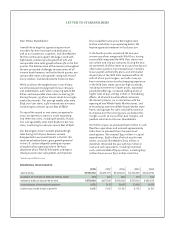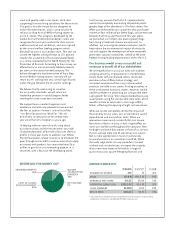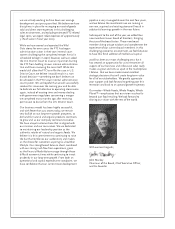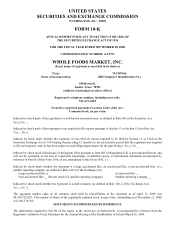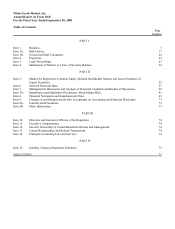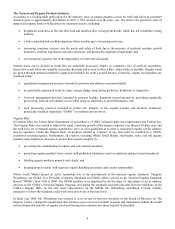Whole Foods 2008 Annual Report Download - page 13
Download and view the complete annual report
Please find page 13 of the 2008 Whole Foods annual report below. You can navigate through the pages in the report by either clicking on the pages listed below, or by using the keyword search tool below to find specific information within the annual report.
implementing partners are utilizing the loans for home-based businesses such as poultry and pig farming, agriculture,
furniture making, tailoring, and selling handicrafts, homemade and bakery-made foods, clothing and footwear. The Whole
Planet Foundation hopes to expand its projects in 2009 to include micro-lending in Peru, Mexico, Argentina, Thailand and
China, where Whole Foods Market sources coffee and tea through its Allegro Coffee Company, as well as rice, grain, fruits
and vegetables.
Today, more than one billion people are living on less than $1 a day. Whole Foods Market covers all operating costs and the
overhead budget for the Whole Planet Foundation, and directs $1 million annually, funded in part by the sale of products
under the Company’s Whole Trade Guarantee program, to its micro-lending projects. Join us in empowering entrepreneurs in
the global community by donating online at www.wholeplanetfoundation.org. We have included the foundation’s website
address only as an inactive textual reference. The information contained on the website is not incorporated by reference into
this Report on Form 10-K.
Green Action
Supporting wise environmental practices is part of our core values and strengthens our commitment to being a leader in
environmental stewardship. This means making decisions that positively impact the health of our planet, its people and its
resources. Our Green Mission Task Force, comprised of team members and leadership across the Company, is empowered to
act on initiatives that support our Green Mission. In 2008, we held our first ever Green Mission Congress, bringing together
representatives from each of our regions to share best practices and set Company-wide intentions for energy efficiency, green
building, and waste stream reductions
.
Renewable Energy. Whole Foods Market uses a comprehensive alternative energy approach to reduce its reliance on fossil
fuels. Over the years, we have purchased more than 1.2 million megawatt hours of wind-based renewable energy. Our
commitment to renewable energy purchasing has earned us Environmental Protection Agency (“EPA”) Green Power awards
for the last four years. Our Berkeley, CA store was the nation’s first major food retailer to introduce solar energy as its
primary lighting source in 2002. We now have close to a dozen locations either hosting or using solar power to supplement
traditional power, including one of the largest solar arrays in the state of Connecticut at our distribution center. We also
purchased an on-site hydrogen fuel cell at our new Glastonbury, CT store, enabling the store to generate 50 percent of the
electricity and heat and nearly 100 percent of its hot water needs on-site using fuel cell technology.
Energy Reduction and Efficiency. Whole Foods Market is investing in energy monitoring equipment to identify system
reduction opportunities, and we are investing in retrofits of existing stores with more energy efficient lighting, equipment,
and mechanical components. The Company is also upgrading its equipment and systems to improve energy efficiency in new
stores, efforts that may reduce energy consumption by 10 percent to 50 percent in certain stores. In addition, the recent
implementation of a Company-wide energy and refrigerant tracking program is enabling us to develop a greenhouse gas
emissions inventory; preliminary emissions reduction targets have been set but not yet published.
Green Construction. We build our new stores with the environment in mind, using green building innovations whenever
possible. This includes reducing the amount of virgin raw materials used in construction and choosing eco-friendly
laminates, paint and carpeting to minimize toxic resins and volatile organic compounds released into the atmosphere. We
also recycle construction debris and reuse equipment where possible. Our store in Sarasota, FL received Silver Leadership in
Energy and Environmental Design (“LEED”) certification by the U.S. Green Building Council, the first ever
environmentally friendly supermarket designed in accordance with the LEED Green Building Rating System. Our flagship
store in Austin, TX is also LEED-certified, and our El Segundo, CA store is LEED-CI (Corporate Interiors) certified.
Additionally, we have approximately 20 stores registered to become LEED-certified and more under development.
Encouraging Reusable Grocery Bags. Whole Foods Market discontinued the use of disposable plastic grocery bags at the
checkouts in all stores in the U.S., Canada and the United Kingdom on Earth Day, April 22, 2008. We strongly encourage
our customers to use reusable grocery bags by providing affordable bags, including our $0.99
A Better Bag
made from
recycled plastic bottles, and by paying at least a nickel per bag refund at the checkout. Between Earth Day and the end of
2008 alone, we estimate that we will keep 100 million new disposable plastic bags out of our environment.
Composting and Recycling. Nearly all of our stores are involved in a recycling program, and most participate in a
composting program where food waste and compostable paper goods are regenerated into compost. Additionally, in 2007,
we introduced an all-natural fiber packaging that is a compostable, environmentally friendly alternative to traditional
petroleum and wood- or tree-based materials. Its fibers come from plants that are cultivated or grow wild and are harvested
annually. We are also working to eliminate the use of Styrofoam packing materials in product shipments to our Company.
7


